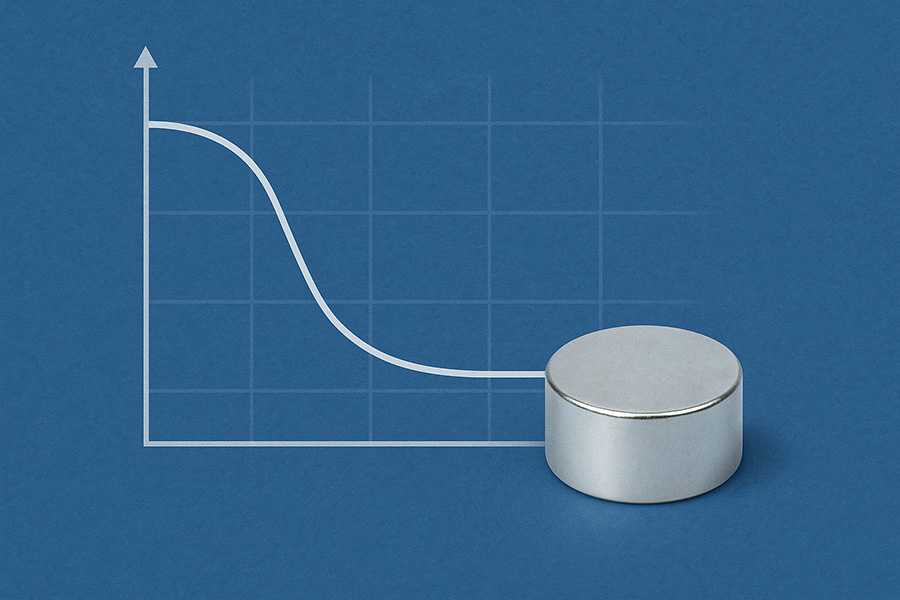Hey there!
Let’s dive into the fascinating world of magnet residual induction.
It’s also known as remanence or residual magnetization.
It is really cool how this property of magnets relates to the materials we work with.
So, what exactly is residual induction?
And why should you care about it?
Let’s break it down!
What is Magnet Residual Induction?
Residual induction is the magnetization that remains in a ferromagnetic material like iron.
It remains after an external magnetic field is removed.
- In other words, it’s the magnetic memory that sticks around.
- Even when the magnet isn’t being directly magnetized anymore.
Key Points
We measure residual induction by the symbol Br.
- The units of magnetic flux density are gauss (G) or tesla (T).
It’s the value at a specific point on the hysteresis loop.
- This is where the magnetizing force H goes back to zero.
- After the material was magnetized all the way to saturation.
Residual induction is super important for characterizing permanent magnets.
It tells you the strongest magnetic field a permanent magnet can produce on its own.
- For example, mighty neodymium magnets have a Br around 1.0-1.3 tesla! That’s impressive.
The composition, microstructure, and processing of a material determines its residual induction.
- We carefully engineer permanent magnets to maximize their Br.
If you want to get rid of unwanted residual magnetization, you have to degauss it.
This is common for things like transformer cores.
So in a nutshell, residual induction quantifies how well a magnet can hold onto its internal magnetic field.
- This is after being fully magnetized.
- The higher the Br value, the stronger the permanent magnet.
- This property is key for all sorts of permanent magnets.
We use them in so many applications.
Measurement
Now that we know what residual induction is, how do we actually measure it?
There are several common methods and tools.
We use them to determine the remanence of magnetic materials:
Residual Magnetic Field Meters (Gaussmeters)
These handy devices directly measure the residual magnetic field on a magnetized surface.
They use sensors.
- For example, the List-Magnetik MP-80.
- Just put the probe near the surface.
- Then it displays the residual flux density.
B-H Loop Tracers
B-H analyzers measure the entire hysteresis loop of a magnetic material.
- They do this by applying a varying field. And measuring the induced flux density B.
- The Br value is where H goes to zero after saturation.
This is a go-to method for characterizing permanent magnets.
Vibrating Sample Magnetometers (VSM)
A VSM wiggles the sample next to a coil.
It measures the induced voltage to determine the magnetic moment.
- Saturate the sample, remove the field.
- And the moment at zero field gives you the remanent magnetization Mr. It’s a useful technique.
Magnetic Force Microscopy (MFM)
An atomic force microscope with a magnetic tip can map out the variations in stray fields from a sample surface.
- This lets you visualize magnetic domains.
- And estimate remanent magnetization at the nanoscale.
- It’s great for small samples!
There are even more techniques.
- Like Magnetic Barkhausen noise analysis, inverse methods, and more.
The right tool depends on several factors.
- Your sample size, geometry, resolution needs.
- And if you can destroy the sample or not.
Handheld meters and B-H analyzers are popular for bulk samples.
While microscopy is used for the really tiny stuff.
Always make sure your tools are properly calibrated.
This ensures reliable remanence measurements!
Impact
So how does residual magnetization actually affect things we use?
Let’s look at a couple key examples:
Electric Motors
Residual magnetization in rotor magnets can cause cogging torque.
It’s an annoying torque ripple that happens even when the motor isn’t powered.
- Higher Br means more cogging.
Which leads to vibration, noise, and positioning errors at low speeds.
- The residual magnetization helps with starting the motor.
- It does this by providing some initial air gap flux.
- But if it’s too high, it can saturate the magnetic circuit.
- And reduce the starting torque.
It’s a balancing act.
The Br level contributes to the motor’s overall torque and efficiency.
- The right amount of residual magnetization boosts performance.
- But too much causes losses and reduces efficiency.
It’s important to get it right.
Residual magnetization in shafts and components can create damaging currents.
And discharges in the bearings.
This reduces their lifespan.
Induction Motors
Residual flux in the stator core bumps up hysteresis and eddy current losses.
- This increases the overall core losses and heating.
- The alternating domains have to fight against more residual “opposition.”
It’s a tug-of-war.
A little residual magnetization actually helps by reducing the magnetizing current needed.
- To create the rotating field.
- This improves efficiency and power factor.
Especially at light loads.
Like other motors, residual magnetization provides some initial starting torque.
- But if it’s excessive, it saturates the magnetic circuit.
- And hurts the locked-rotor torque and starting performance.
Too much of a good thing is bad.
High residual magnetization can saturate parts of the magnetic circuit.
- Lowering the torque capability.
- And forcing the motor to run at a less efficient operating point.
- Derating is no good!
Stray residual fields induce circulating currents in the shaft and frame.
- Causing extra heating and losses that sap efficiency.
- It’s like an invisible energy thief.
DC Motors
DC motors also benefit from residual magnetism for producing starting torque.
- When the motor is at rest, the residual flux in the field magnets/poles interacts with the armature current.
This gives an initial torque kick.
Higher residual flux means more starting torque for the same armature current.
- But low or decayed residual magnetization means a weaker starting torque.
- It’s important to maintain healthy residual magnetization levels.
This effect is strongest in DC motors with wound fields.
- Rather than permanent magnets.
- Since PM motors have pretty stable residual magnetization.
- Unless the magnets degrade.
Overheating can demagnetize the field magnets/poles over time.
- This decreases the residual flux and starting torque performance.
- Keep those motors cool!
- Proper thermal management is key.
Motor designers have to carefully optimize residual magnetization levels.
To balance efficiency, torque, starting performance, and loss effects.
It’s like a big puzzle to get the best motor characteristics.
While avoiding saturation and overheating troubles.
Sources
Where does this pesky residual magnetization come from anyway?
There are a bunch of common culprits:
Magnetic materials like iron and steel naturally retain some magnetism.
- We call this remanence.
- Even with no magnetizing force, they hold onto some of that magnetic mojo.
- It’s like a magnetic memory.
Manufacturing processes sometimes expose motors to strong magnetic fields.
- For things like crack inspection.
- If the parts aren’t demagnetized properly afterward, that magnetization sticks around.
- As residual flux.
Electrical faults like short circuits, ground faults, and lightning strikes create huge currents and magnetic fields.
- They can magnetize the motor’s core materials.
- Now it’s got residual magnetization.
Motors run by variable frequency drives (VFDs) can get residual magnetization.
- Due to the non-sinusoidal voltages VFDs output.
- These funky waveforms cause uneven magnetic saturation.
- And remanent flux trapped in the cores.
Manufacturing defects like off-center rotors, lumpy air gaps, or crooked shafts create unbalanced magnetic pull.
- This concentrates residual magnetization in certain areas.
- Defects are a problem.
Stray currents zipping through the motor shaft or frame from induced circulating currents can magnetize those components.
- And leave residual fields behind.
Too much heat during operation can mess with the magnetic properties of the motor materials.
- Changing how they retain or release residual magnetism.
- Temperature affects magnetization.
The effects of residual magnetization cover everything from extra core losses and vibration to bearing damage and permanent magnet weakening.
Motor designers have to be clever with their material choices, manufacturing steps, and demagnetization procedures.
To keep residual magnetization in check.
Wrap Up
To recap, residual magnetization or remanence is the magnetic field that stubbornly sticks around in a material.
Even after the magnetizing force goes away.
It’s a key property of permanent magnets measured by the residual induction Br. Residual magnetization can be good or bad in electric motors.
It helps with starting torque but can also cause losses, vibration, and saturation issues if it’s too high.
I hope this gives you a helpful overview of magnet residual induction.
If you need custom strong magnets, just let us know!



